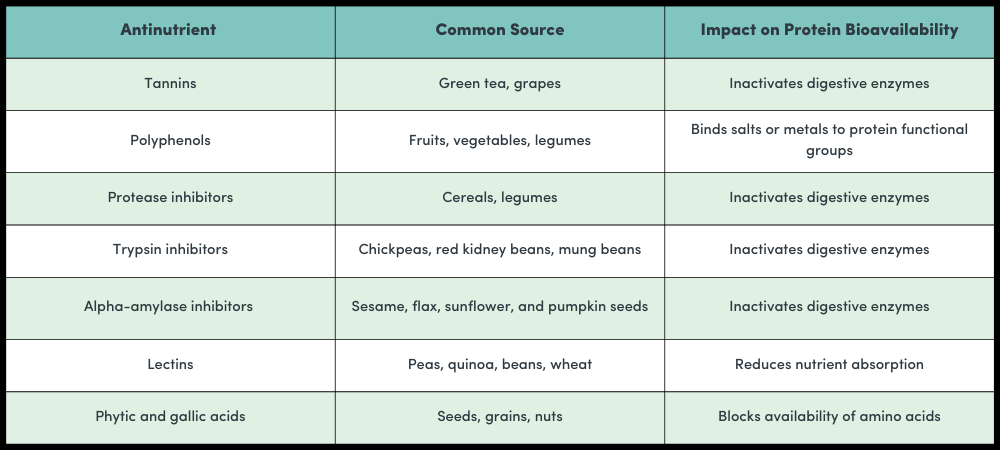What is Fermented Protein and Why Does it Matter?

There are many health advantages to consuming adequate protein, but not all proteins are created equal. As you may have read in previous articles, consuming a plant-based diet can present some challenges. In part, this is because plants don’t individually contain all the essential amino acids (the building blocks for proteins), meaning you will have to mix and match plant proteins to consume all the amino acids you need.
Additionally, plant proteins are less bioavailable than animal proteins, meaning it is more difficult for your body to digest and use plant proteins. The reason for this lower bioavailability comes from the structure of the plant proteins and how they are packaged. Specifically, plant proteins are packaged with a high concentration of compounds that bind them and make them difficult to access. These compounds are commonly known as “antinutrients”. Here is a list of several antinutrients found in plants, some common foods that have them, and their impact on protein availability [1].

While this is not a comprehensive list, it does allow us to appreciate the breadth of antinutrients found in plants. However, this does not mean that you should stop eating plants (especially vegetables). Plants provide vitamins, minerals, fiber, and many other nutrients that are very good for you. Just be aware that you are probably not absorbing as much of the protein from these sources as you might think. So, what can be done to improve the bioavailability of protein from plant sources? Thankfully, there are a few options.
Option A: Soaking
Soaking is a physical process widely used for removing soluble antinutritional factors and reducing cooking time. This method is particularly effective for plant foods like almonds, nuts, grains, and edible seeds, as it enhances the release of enzymes, such as endogenous phytases. Anti-nutrients, which are often water-soluble, can be removed through leaching during soaking. However, soaking may lead to the leaching of some important water-soluble proteins and minerals, posing potential disadvantages [2].
Option B: Cooking
Research suggests that controlled heating at temperatures below boiling point for approximately 15 minutes can effectively minimize the presence of antinutrients in food [3]. This process can reduce antinutrients like phytic acid, tannins, protease inhibitors, and oxalic acid from grains, beans and vegetables. It may also break down complex proteins into simpler forms that are more easily absorbed and used in the body. Cooking may also denature and leach out some of the proteins from food, leading to a nutrient loss.
Option C: Germination
This option applies to seeds which, when sprouted, reduce phytate and phytic acid. This is a common method used to reduce antinutrients in cereals [4], but is not as effective as other methods.
Option D: Fermentation
Based on the title of this article, you could probably guess that fermentation is becoming a preferred method for improving the bioavailability of plant proteins. Fermentation has been used for centuries as a means of preserving foods (think kimchi, sauerkraut, yogurt, kombucha, sourdough bread, etc.). In this process, we let microorganisms like bacteria or fungi do all the work of breaking down the antinutrients of foods. A recent study demonstrated that using shiitake mycelium (fungus) to ferment a pea and rice protein blend improved their digestibility, nutritional value, flavor, and functionality [5]. They found that fermentation of these two plant-based proteins reduced papain inhibitors and phytate levels.
Why pea and rice proteins specifically? Because these two plant sources complement each other very well to provide a more complete amino acid profile. Pea protein is low in the amino acids cysteine and methionine, but high in lysine and rice protein is low in lysine, but high in cysteine and methionine. While fermenting this pea and rice blend doesn’t make them perfectly digestible, it dramatically improves the availability of their micro and macronutrients.
Fermenting plants not only makes their proteins more available, but it does so with minimal leaching like cooking and soaking methods. Plus, you get an added bonus with fermentation because the microorganisms also consume starches and sugars. This reduces total starch and sugar intake, leading to lower blood glucose and insulin effects. The bacteria used in the fermentation process can also improve gut health as they act as probiotics. It’s a win-win-win situation.
Hopefully, this gave you some food for thought (pun intended). If most of your diet is plant-based, I would argue that it is vital to utilize these tools to improve the protein availability. And for those who are more omnivorous, please also consider adding fermented foods to your diet for the added benefits they provide.
References
- https://jabonline.in/abstract.php?article_id=575&sts=2
- https://link.springer.com/article/10.1007/s13197-012-0638-7
- https://www.foodandnutritionjournal.org/volume2number3/changes-in-anti-nutrients-contents-of-edible-vegetables-under-varied-temperature-and-heating-time/
- https://www.ccsenet.org/journal/index.php/jfr/article/view/20933
- https://www.sciencedirect.com/science/article/pii/S0023643821022180#bib25
This article is for informational and educational purposes only. It is not, nor is it intended to be substitute for professional medical advice, diagnosis, or treatment and should never be relied upon for specific medical advice.


















